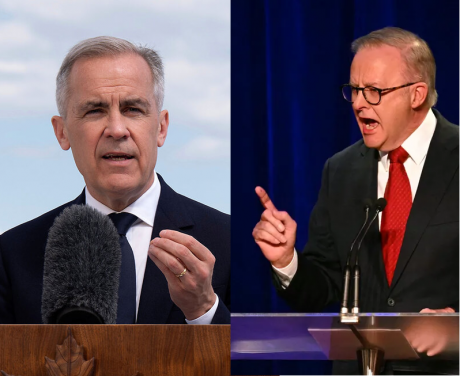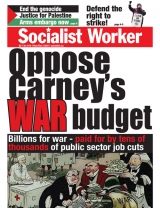Reports
You are here
Trump fears and centrism at the heart of Canadian and Australian elections

May 10, 2025
The Canadian and Australian nation-states, both of whom still share the British monarchy as their unelected head of state, re-elected their respective incumbent governments within days of each other on April 28th and May 3rd.
The Canadian Liberals, led by Mark Carney, were elected as part of a minority government, and the Australian Labor Party, ALP, led by Anthony Albanese, won with a large majority. These results constituted a dramatic U-turn from only two months earlier, when both parties seemed more than likely to lose to their reactionary counterparts, Pierre Poilievre of the Canadian Conservatives and Peter Dutton leading the Coalition of the Australian Liberal Party and National Party.
The effects of inflation, wage stagnation, and unmanageable costs of living were among the issues that contributed to the Canadian Liberals' and ALP's decreasing popularity. Both leaders had proved they would not actualize their empty rhetoric on causes such as anti-racism, ecological justice, and indigenous rights.
anti-union
Both nations aggressively increased repression of union activity. The Liberals used the Canadian Industrial Relations Board to impose back to work orders on the Canadian Union of Postal Workers (having done so four times in 2024 alone) and Australian Labor forced one of the nation’s most militant unions, the Construction, Forestry, and Maritime Employees’ Union (CFMEU) into administration—assisted by vicious anti-union media coverage. The consequences have been far-reaching and profound, including a backlash against the ALP by its historically loyal blue-collar voter base.
Progressive voters who may have hinged their hopes on a better society from having elected the “sensible alternative” or the “lesser evil” in the centre, were horrified to witness both parties’ unwavering support of the Israeli state in its twenty months of genocide in Palestine.
Both governments had significantly escalated their anti-immigrant rhetoric, scapegoating international students for their respective housing crises rather than point their fingers at out-of-control property speculation by ultra-wealthy capitalists. In the case of Albanese’s Labor, the anti-immigrant rhetoric even competed with the party’s conservative opponents. In both cases, the racist discourse has been rooted in a mistaken belief that being tough on immigration and blaming immigrants for economic hard times and social unrest would help to turn around voter sentiment back in their favour.
Records of empty promises
The Canadian Liberals and Australian Labor were both originally elected on proclamations that they would take real action on the climate and ecological crisis. Yet the Liberals constructed new oil and gas pipelines as part of Justin Trudeau’s confused claims that they were part of the plan for a greener economy and the Carney government has committed to “traditional” (in other words, fossil fuel) energy sources, while using manipulative accounting to allege improvements in global emissions targets. Meanwhile, Albanese, on his election in 2022, had said he would “end the climate wars” with ambitious targets and “green trade partnerships” with countries in the region such as Indonesia. Since then, he has approved a dozen coal developments and five oil and gas projects, and has introduced a “safeguard mechanism,” a system of carbon credits and offsets that allow corporations to avoid replacing fossil fuels with renewables.
All of this was ultimately overshadowed by Trump’s announcement of a global trade war that included Canada and Australia, allowing the leaders of otherwise steadfast US allied nations to frame themselves as heroic defenders of so-called national sovereignty, where their conservative opponents were versions of Trump.
In a situation considered unusual in both countries, the opposition leaders lost their seats in a swing against them as individual candidates, not only as party members. Voters in Canada and Australia heard echoes, in the rhetoric of these conservative candidates, of the Trump’s extreme, reactionary politics enacted through sexist, homophobic, and transphobic policies, ad hoc deportations based on racism and repression of Palestinian solidarity activists, and the slashing of entire public sector workplaces. The fear of living with some version of these policies led many progressive voters away from the New Democratic Party of Canada (NDP) and the Australian Greens to a “strategic vote” for the centrist major parties. Both the Canadian NDP and Australian Greens, while not directly comparable, have candidates who publicly support Palestine, have more progressive policies on social issues and labour, and can exert some limited pressure on the more conservative parliamentary representatives of the larger parties. Yet their capacity to effect true change is always counteracted by their need to function within the bounds of a capitalist state.
The dire effects of a Trump government in the US may have temporarily shielded the failures of centrist parties such as the Liberals and the ALP, but not for long. They are both reformist parties that operate right down the middle of settler-colonial, capitalist nation-states, each working to advance their own competitive imperialist interests and motivations. It is no solution to defer to those who run neoliberal capitalism with kinder words and strident nationalism, where people are encouraged to support their own ruling classes to avoid the domination of the bigger sibling across the border or the ocean. To avoid the continued growth of international far-right currents, the myriad crises that workers and oppressed peoples face around the world require far deeper interventions of the kind that threaten capitalism and imperialism at their core.
Section:










